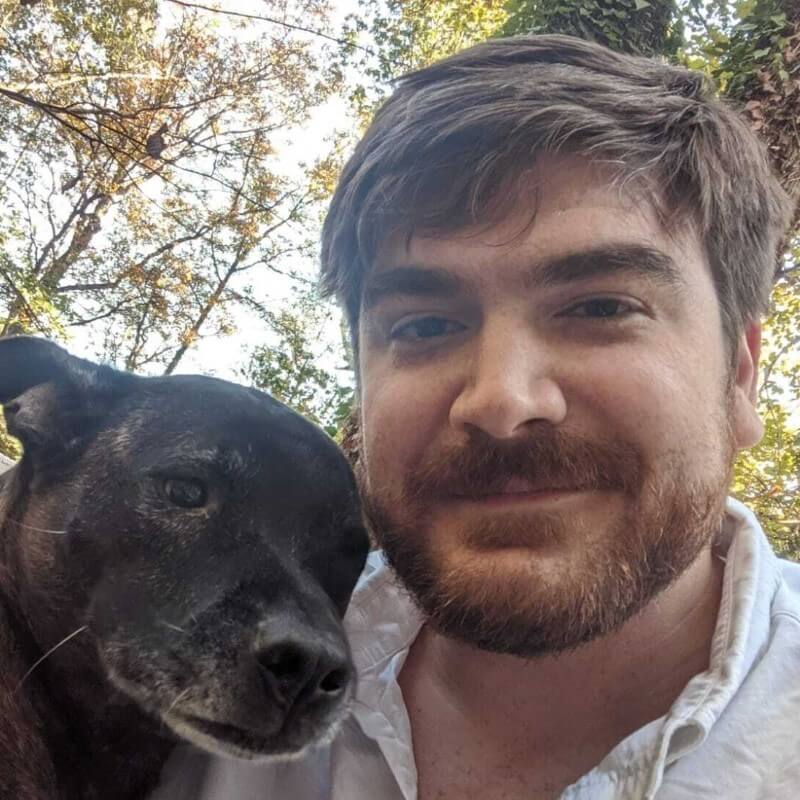The Poly Age
Dr. Andrew Prudhom had jumped from one relationship to another, struggling with his own identity, feelings, and desires while trying to maintain his role as a faithful partner.

As one relationship ended, another would begin, and the reason for why that happened varied from case to case: the romance had dried up, they needed time apart and never reconnected, or he had fallen in love with someone else and it made maintaining a monogamous relationship difficult.
Related: The Best Polyamorous Dating Sites to Help You Find a Polyamorous Relationship: Updated 2022

Monogamous relationships have for a long time been a formative pillar to cultural, social, religious, and legal structures in countries around the world. However, growing polyamory communities around the world have discovered within themselves and through the support of one another an alternative to monogamy that better resonates with how they approach relationships, love, sex, and marriage.
For Dr. Prudhom, the framework of a committed traditional relationship was a struggle, and it clashed directly with who he truly was. For him the option of an open relationship didn’t seem like the right decision. Instead, he was introduced to the polyamorous community, which for him offered up something unique with regard to ethical non-monogamy and open relationships.
An open relationship allows partners to have sex with other people but does not have any structure in place for allowing for the development of romantic feelings. This is the fundamental difference in my mind between ethical non-monogamy and polyamory – ethical non-monogamy is more sexual in nature, while polyamory allows for romantic feelings.
– Dr. Andrew Prudhom
Table of contents [ Show Hide ]
How many polyamorous people are out there?
Writing for Rolling Stone, Zachary Zane points out that the recent growth of polyamorous communities is significant, numbering at 4-5% of the population, with 20% having at least attempted it. He states that the reason he believes why this number is so high is because polyamory is simply “being open to the idea of loving more than one person and having a serious relationship with multiple people at the same time.”
YouGov’s research shows that the majority of Americans (68%) would not be OK if a partner is engaging in sexual activities with someone else. At the opposite, 5% would be OK with it, while 19% say that it depends on the circumstances. Although most young Americans (56%) outright reject anything other than strict monogamy, it is still a higher rate of acceptance than in previous generations.

Polyamory statistics are a difficult number to find, and the exact figure may almost always be lower than the reality, finds Elisabeth A. Sheff Ph.D., CSE in Psychology Today and explain why polys are mostly hiding their relationships:
“Like other sexual minorities, polyamorists have good reason to hide their relationships from the general public because being exposed as sexually or relationally unconventional can mean loss of employment, housing, relationships with friends and families of origin, or custody of children. With so much to lose, it is no surprise that polys and other sexual or relational non-conformists sometimes hide their relationships.”
– Elisabeth A. Sheff Ph.D., Psychology Today
However, there are an estimated 9.8 million polys in the USA, an estimate provided by Kelly Cookson, the researcher behind the numbers.
“It appears that sexually non-monogamous couples in the United States number in the millions. Estimates based on actually trying sexual non-monogamy are around 1.2 to 2.4 million. An estimate based solely on the agreement to allow satellite lovers is around 9.8 million. These millions include poly couples, swinging couples, gay male couples, and other sexually non-monogamous couples”
– Cookson for Psychology Today
According to a 2017 study in the USA that included a survey of almost 9,000 single adults, more than one in five engaged in consensual non-monogamous sex in their lifetimes, and an estimate from an earlier survey in 2014 suggests that 4%-5% of Americans are openly in non-traditional relationships with multiple partners.
The rise of polyamory
The sexual revolution initiated over 50 years ago has left an indelible mark on the psyche of one generation after another, introducing the idea of ‘free love’, the idea or practice of having sexual relations according to one’s choice, without restriction.
The result of these changes is that people have displaced and done away with the many normative and traditional lifestyles and views that held sway over Western culture. This includes a growing understanding and acceptance toward homosexuality and female sexuality, women’s rights, the rights of transgender people, and strictly monogamous relationships. The outcome has been a proliferation of new expressions of identity, loving relationships, and experiences.
As more people openly admit to being involved in poly relationships, an awareness of their identity in broader communities becomes clearer. It also includes younger generations simply being more mobile and experimental, sometimes even having less time for monogamy than older generations.
Dr. Prudhom also noticed a growing trend in the community:
“The polyamorous community is still small, but growing. It is much more prevalent in population centers – similar to most methods of having relationships outside of the cis/het norm. The community overall is very accepting of new people – most of us were raised to believe that you can only love one person and anything else is ‘cheating’ – we have all been the clueless new person, and as such we welcome questions”
Today these communities can openly and proudly declare their identity, orientation, and philosophy in ways that were impossible decades ago. These communities also continue to grow and demonstrate a supportive role in fostering alternative lifestyle approaches to relationships.
However, this isn’t to say that such openness and tolerance is universally seen across Western culture, as there are still many places which demonstrate an intolerance for non-normative relationships and behavior. Nevertheless, progress has been made and continues to be made.
Online dating is a popular service for polyamorists
Online dating has undoubtedly been crucial to the exploration of people’s sexual boundaries and identities, giving many the means to join communities for both casual and serious dating opportunities. This can be done discreetly or openly, as it is flexible to the user’s desire. The ease of access to online dating has given people simpler ways to quickly meet people in communities they might not have otherwise met, or if they are simply passing through a city.
As such, people who identify as being in non-monogamous relationships, such as an open relationship, a polyamorous one, or something else, have increased dramatically on such dating sites as Tinder, Zoosk, and Badoo, just to name a few.
Online dating isn’t a necessity for polyamorous dating, but it has paved the way for making these kinds of relationships easier to pursue and participate in, and have helped to give people a way to explore non-monogamy.
What kind of polyamory relationships exist?
Non-monogamous relationships are diverse in nature and can vary depending on the individual’s perception of what they find ideal for a relationship to be defined as. This can also vary depending on the location of one’s partners, the frequency they see each other, and how flexible they are with their own approaches to relationships.
For Dr. Prudhom, the definition of polyamory is simple: “My personal definition of polyamory is pretty similar to straightforward translation: Many loves. To me, to be polyamorous simply means you are wired in such a way that you can hold romantic feelings for multiple people without simultaneously having your feelings for one person detract from your feelings for another.”
Speaking about what kind of relationships one could find in a polyamorous lifestyle, Dr. Prudhom explains:
“There are endless combinations of relationships that fall under the polyamorous umbrella. You can be Solo Poly, the best definition of which I have heard is that you are ‘your own primary partner’ and your relationships are less important than caring for yourself. You can have primary partnerships like I do, where you have people you consider to be your ‘partners’ who you love and share your life with, as well as others who are dear to you, but are not considered partners. These could be sex partners or romantic friendships.“
Relationships also need not be limited by how frequently couples manage to see each or even if they live anywhere near one another, as Dr. Prudhum explains: “There is the idea of ‘comet’ relationships, which are relationships you have with people living far away that are on when you are in town, and off when you aren’t (they flare to life when proximity is close, like a comet to the sun)”.
However, having a nonsexual relationship also could be common in poly communities.
“A very special (to me) aspect of polyamory is that you can have nonsexual romantic relationships without depriving yourself of sexual contact. What happens if you are monogamous and fall in love with an asexual individual? You either don’t enter a relationship with them, or you do and no longer have regular sex. In a polyamorous setup, you can commit fully and wholly to a relationship with an asexual person while also being able to get your own needs met (assuming you are not yourself asexual.)”
– Dr. Prudhom

These are some of the leading dating apps in the match-making market. Sign-up today for free:
- Most popular dating app in US
- 100% match assured
- Numerous positive reviews
- Meet real asian, european, and latino singles
- Real-time communication with efficient tools
- Professional dating services
- 24 hrs customer service
- One on one Romance Consultations.
- 100% real users.
- Large database of verified & attractive Asian and European singles
- Efficient communication and instant messaging
- Top-level safety and professional support
What are the benefits and difficulties of being a polyamorist today?
As with any other relationship, it is normal that polyamory relationships have some difficulties. Some of the more common issues that trouble people in polyamorist relationships include:
- Time management can be a real issue, as when one has multiple partners it means they must divide their time up in a way to make sure that everyone receives the kind of attention they would like.
- Although unfortunate, a common problem can happen when one partner has significantly more power over the other(s), such as when they have more resources at their disposal or are considerably more attractive and can initiate new relationships with more ease.
- As communication is vital in a polyamorous relationship, those who have difficulty doing so, or are simply inarticulate with certain things, can inevitably find themselves at a disadvantage.
What many people who are new to polyamory forget or don’t realize is that a polyamorous relationship demands more commitment than monogamy. Dr.Prudhom agrees about the main difficulties and adds: “The biggest difficulty is that things are more complicated. You need to be able to effectively communicate. You need to be ABSOLUTELY sure you are practicing safe sex practices, because the moment you mess up you are potentially transmitting STIs to people you care about.
There is a lot of time devoted to maintaining relationships – polyamory is simultaneously easier and harder than monogamy. It is easier because you can shed all of the monogamous baggage that we were raised with. You have the freedom to fit the relationship to exactly your specifications and tell society to screw off. The difficulty comes in the work required to make these decisions.”
But these issues cannot eclipse some of the clear benefits that people in polyamorous relationships enjoy beyond simply being able to express themselves in a way that is honest to who they are and how they feel. These benefits include:
- Freedom to discuss problems, either personal or otherwise, with multiple partners. This can mean that mediation is easily available and the potential for polarized opinions is limited.
- There is a broader emotional support structure from those within the polyamorous relationship. There can also be support for marriages where no one wishes to have children, as regardless of sex, the romantic needs are still being met.
- People in the relationship can enjoy a broader range of experiences, skills, resources, and perspectives.
- There is a greater amount of emotional, intellectual and sexual needs being met as all parties involved understand that one person should not be expected to provide for every need someone may have. Contrary to monogamy, one need not be a jack-of-all trades when it comes to providing in a relationship, as there are multiple people to help.
Speaking about his own positive experiences of being a polyamorist, Dr.Prudhom highlighted this possibility to experiment.
“The biggest positive for me is the ability to unashamedly love whoever I want to love. If I meet a remarkable new individual, I can develop feelings for them without thinking that I am somehow betraying someone I care deeply about. The ability to have varied sexual experience is also quite nice. I used to get “stuck in a rut” in my monogamous sexual relationships – this is not the case when I am frequently having new sexual partners”, said Dr.Prudhom, adding:
“Another positive is the room for experimentation. Since becoming polyamorous, I have been able to pursue experiences that I previously could only pursue in-between relationships. I am attracted to femininity – this includes transwomen and effeminate men. I likely would have never made this realization if I was in monogamous relationships because I wouldn’t be able to experiment without cheating on my partner.”
Dr. Prudhom’s journey toward self-discovery about his own identity and the way he approaches relationships is an example of one that was successful and accepted by friends and family. However, this process is not always met with the same sort of openness that he found, and some people may feel held back from being who they truly feel themselves to be out of fear of negative reactions to their lifestyle decisions.
Ultimately, the world is a brighter, more interesting place when people are honest with themselves and one another about who they are and what they identify as. For some, the fear of being outed for who they are prevents them from doing so. It takes courage to identify yourself as something non-normative, and even though the consequences for doing so may have short term repercussions, it is nevertheless true that there are people – perhaps strangers to you – who will love and admire you for your bravery.



